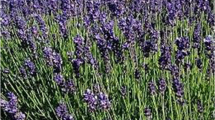Abstract
Chiisanogenin (1), hyperin (2) and chiisanoside (3) were isolated from the leaves ofAcanthopanax senticosus, and were tested for their inhibitory activities against 6 strains of bacteria. Among them, chiisanogenin (1) revealed broad but moderate antibacterial activities against G (+) and G (−) bacteria, the minimum inhibitory concentration (MIC) being in the range of 50–100 μg/ml.
Similar content being viewed by others
References
Chen, Z. W. and Ma, C. G. Effects of hyperin on free intracellular calcium in dissociated neonatal rat brain cells.Acta Pharmac. Sin., 20, 27–30 (1999).
Davydov, M., and Krikorian, A. D.Eleutherococcus senticosus (Rupr. & Maxim.) Harms (Araliaceae) as an adoptogen: a closer look.J. Ethnopharmacol., 72, 345–393 (2000).
Hahn, D. -R., Kasai, R., Kim, J. -H., Taniyasu, S. and Tanaka, O. A new glycosyl ester of a 3,4-seco-triterpene from Korean medicinal plant,Acanthopanax chiisanensis (Araliaceae).Chem. Pharm. Bull., 32, 1244–1247 (1984).
Kasai, R., Matsumoto, K., Taniyasu, S., Tanaka, O., Kim, J -H., and Hahn, D-R. 3,4-Seco-lupane type triterpene glycosyl estersfroma Koreanmedicinal plant,Acanthopanax chiisanensis (Araliaceae).Chern. Pharm. Bull., 34, 3284–3289 (1986).
Li, X-C., Barnes, D. and Khan, I. A. A new lignan glycoside fromEleutherococcus senticosus.Planta Med., 67, 776–778 (2001).
Nishibe, S., Kinoshita, H., Takeda, H. and Okano, G. Phenolic compounds from stem bark ofAcanthopanax senticosus and their pharmacological effect in chronic swimming stressed rats.Chern. Pharm. Bull., 38, 1763–1765 (1990).
Perry, L. M. Medicinal plants of East and Southeast Asia. MIT press, Cambridge, Massachusetts and London, p. 41 (1980).
Wald, B., Galensa, R., Hermann, K., Grotjahn, L. and Wary, V. Quercetin-3-O-[6″-(3-hydroxy-3-methylglutaroyl)-β-galactoside] from blackberries.Phytochemistry, 25, 2904–2905 (1986).
Wu, M. and Hancocks, R. E. W. Interaction of the cyclic antimicrobial cationic peptide bactenecin with the outer and cytoplasmic membrane.J. Bioi. Chern., 274, 29–35 (1999).
Yook, C. S. Coloured medicinal plants of Korea. Academy Book Co., Seoul, p. 377 (1990).
Yook, C. S., Rho, Y. S., Seo, S. H., Leem, J. Y. and Han, D. R. Chemical components ofAcanthopanax divaricatus and anticancer effect in leaves.Yakhak Hoeji, 40, 251–261 (1996).
Author information
Authors and Affiliations
Corresponding author
Rights and permissions
About this article
Cite this article
Lee, S., Shin, DS., Oh, KB. et al. Antibacterial compounds from the leaves ofAcanthopanax senticosus . Arch Pharm Res 26, 40–42 (2003). https://doi.org/10.1007/BF03179929
Received:
Issue Date:
DOI: https://doi.org/10.1007/BF03179929




